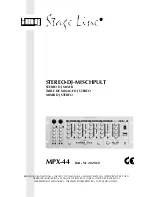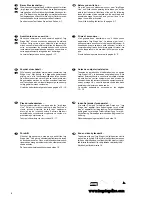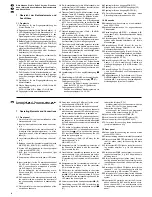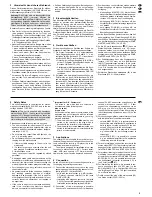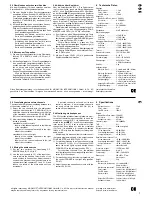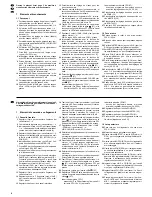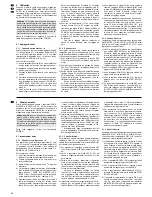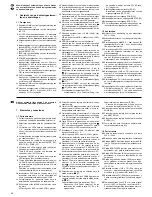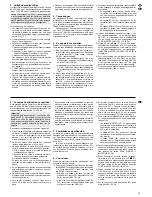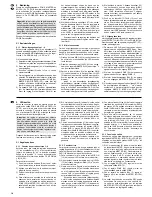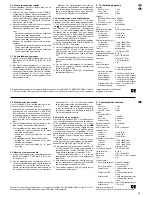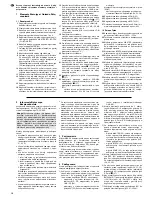
Bitte klappen Sie die Seite 3 heraus. Sie sehen
dann immer die beschriebenen Bedienelemente
und Anschlüsse.
1
Übersicht der Bedienelemente und
Anschlüsse
1.1 Frontseite
1 Gain-Regler für die Eingangsverstärkung der
Stereo-Kanäle 1 – 4
2 Eingangsumschalter für die Stereo-Kanäle 1 – 4
3 LED-Pegelanzeigen für die Stereo-Kanäle 1 – 4:
Anzeige des Pre-Fader-Signalpegels, d. h. des
Signalpegels vor dem jeweiligen Kanalfader (4)
4 Pegelregler (Fader) für die Stereo-Kanäle 1 – 4
5 Balanceregler für das Ausgangssignal der Buch-
sen MASTER (30), BOOTH (31) und ZONE (32)
6 Stereo-LED-Pegelanzeige für das Ausgangs-
signal der Buchsen MASTER (30)
7 BNC-Buchse zum Anschluss einer Schwanen-
halsleuchte (12 V/5 W max.)
8 Ein-/Ausschalter des Mischpults, mit darüber lie-
gender Betriebsanzeige
9 Eingangsbuchsen (sym.) für den DJ-Mikrofon-
kanal DJ MIC und den zweiten Mikrofonkanal
MIC 1; der Mikrofonanschluss ist über XLR- oder
6,3-mm-Klinkenstecker möglich
[Alternativ können auch die jeweiligen Mikrofon-
eingänge (36) auf der Rückseite genutzt werden.]
10 PAD-Schalter für die Mikrofonkanäle: bei nach
unten geschobenem Schalter wird der Eingangs-
pegel des jeweiligen Mikrofons um 15 dB abge-
senkt
11 Gain-Regler für die Eingangsverstärkung der
Mikrofonkanäle
12 3fache Klangregelung (max. ±12 dB) für die Mi-
krofonkanäle:
HIGH = Höhen, MID = Mitten, LOW = Bässe
13 Pegelregler für die zwei Mikrofonkanäle
14 Ein-/Ausschalttasten für die Mikrofonkanäle; bei
gedrückter Taste (LED darüber leuchtet) ist das
jeweilige Mikrofon eingeschaltet
15 Talkover-Taste für den DJ-Mikrofonkanal: bei ge-
drückter Taste (LED darüber leuchtet) werden
bei Durchsagen über das DJ-Mikrofon die Ka-
näle 1 – 4 automatisch um 16 dB abgesenkt
16 PFL-Taste zum Vorhören des Mikrofonkanals
MIC 1 über einen Kopfhörer an der Buchse
(27); bei gedrückter Taste (PFL-Funktion für den
Kanal eingeschaltet) leuchtet die darüber lie-
gende LED
17 3fache Klangregelung (max. +15 dB, -30 dB) für
die Stereo-Kanäle 1 – 4:
HIGH = Höhen, MID = Mitten, LOW = Bässe
18 Zuordnungsschalter für die Überblendfunktion:
Auswahl des Kanals, der eingeblendet wird, wenn
der Crossfader (19) nach links gezogen wird
19 Crossfader zum Überblenden zwischen zwei der
Stereo-Kanäle 1 – 4; die Kanäle werden mit den
C. F. ASSIGN-Schaltern (18 und 20) ausgewählt
(Wird die Überblendfunktion nicht benötigt, beide
Schalter auf „0“ stellen.)
20 Zuordnungsschalter für die Überblendfunktion:
Auswahl des Kanals, der eingeblendet wird, wenn
der Crossfader (19) nach rechts gezogen wird
21 PFL-Tasten zum Vorhören der Stereo-Kanäle
1 – 4 über einen Kopfhörer an der Buchse
(27); bei gedrückter Taste (PFL-Funktion für den
jeweiligen Kanal eingeschaltet) leuchtet die dar-
über liegende LED
22 Lautstärkeregler für den Kopfhörerausgang
(27)
23 Überblendregler PHONES zur Auswahl des Ab-
hörsignals für den Kopfhörerausgang
(27):
Fader ganz links („PFL“)
Vorhören („Pre Fader Listening“) der Kanäle,
deren Taste PFL (16 bzw. 21) gedrückt ist
Fader ganz rechts („PGM“)
Abhören des laufenden Musikprogramms vor
den Ausgangsreglern (24, 25, 26)
24 Pegelregler für den Ausgang ZONE (32)
25 Pegelregler für die MASTER-Ausgänge (30)
26 Pegelregler für den Ausgang BOOTH (31)
27 6,3-mm-Klinkenbuchse zum Anschluss eines
Stereo-Kopfhörers (Impedanz min. 8
Ω
)
1.2 Rückseite
28 Netzkabel zum Anschluss an eine Netzsteck-
dose 230 V~/50 Hz
29 Masse-Klemmschrauben für angeschlossene
Plattenspieler
30 Stereo-Ausgänge MASTER – wahlweise XLR
(sym.) oder Cinch – für den Anschluss des Haupt-
verstärkers
31 Stereo-Ausgang BOOTH (Cinch) für den An-
schluss eines weiteren Verstärkers, z. B. für die
Monitoranlage
32 Stereo-Ausgang ZONE (Cinch) für den An-
schluss eines weiteren Verstärkers, z. B. für die
Nebenraum-Beschallung
33 Stereo-Aufnahmeausgang (Cinch) für den An-
schluss eines Tonaufnahmegerätes; der Aufnah-
mepegel ist unabhängig von der Stellung der
Ausgangsregler (24, 25, 26)
34 Stereo-Eingänge LINE und CD (Cinch) für die
Kanäle 1 – 4 zum Anschluss von Geräten mit
Line-Pegel-Ausgängen (z. B. MD-Recorder, CD-
Spieler)
35 Stereo-Eingänge PH (Cinch) für die Kanäle
1 und 2 zum Anschluss von Plattenspielern mit
Magnetsystem
36 Eingangsbuchsen (6,3-mm-Klinke, sym.) für den
DJ-Mikrofonkanal DJ MIC und den zweiten Mikro-
fonkanal MIC 1; alternativ zu den jeweiligen Mi-
krofoneingängen (9) auf der Frontseite
Please unfold page 3. Then you can always see the
operating elements and connections described.
1
Operating Elements and Connections
1.1 Front panel
1 Gain controls for the input amplification of the
stereo channels 1 to 4
2 Input selector switches for the stereo channels 1
to 4
3 LED level indications for the stereo channels 1 to
4: display of the prefader signal level, i. e. of the
signal level ahead of the corresponding channel
fader (4)
4 Level controls (faders) for the stereo channels 1
to 4
5 Balance control for the output signal at the jacks
MASTER (30), BOOTH (31), and ZONE (32)
6 Stereo LED level indication for the output signal
of the jacks MASTER (30)
7 BNC jack for connecting a gooseneck light
(12 V/5 W max.)
8 Power switch of the mixer with power LED above
it
9 Input jacks (bal.) for the DJ microphone channel
DJ MIC and the second microphone channel
MIC 1; connection of a microphone is possible
via XLR plug or 6.3 mm plug
[As an alternative, the corresponding micro-
phone inputs (36) on the rear panel of the unit
may be used.]
10 PAD switches for the microphone channels: with
the switch in the lower position, the input level of
the corresponding microphone is attenuated by
15 dB
11 Gain controls for the input amplification of the
microphone channels
12 3-way tone control (±12 dB max.) for the micro-
phone channels: HIGH, MID, LOW
13 Level controls for the two microphone channels
14 On-off switches for the microphone channels;
with the button pressed (LED above it lights up),
the corresponding microphone is switched on
15 Talkover switch for the DJ microphone channel:
with the button pressed (LED above it lights up),
the channels 1 to 4 are automatically attenuated
by 16 dB when announcements are made via the
DJ microphone
16 PFL button for prefader listening to the micro-
phone channel MIC 1 via headphones connect-
ed to the jack
(27); with the button pressed
(PFL function activated for the channel), the LED
above the button lights up
17 3-way equalizer (+15 dB, -30 dB max.) for the
stereo channels 1 to 4:
HIGH, MID, LOW
18 Assignment switch for crossfading: selection of
the channel to be faded in with the crossfader
(19) moved to the left
19 Crossfader for crossfading between two of the
stereo channels 1 to 4; the channels are select-
ed with the C. F. ASSIGN switches (18 and 20).
[If crossfading is not required, set both switches
to “0”.]
20 Assignment switch for crossfading: selection of
the channel to be faded in with the crossfader
(19) moved to the right
21 PFL buttons for prefader listening to the stereo
channels 1 to 4 via headphones connected to the
jack
(27); with the button pressed (PFL func-
tion activated for the corresponding channel), the
LED above the button lights up
22 Volume control for the headphone output
(27)
23 Crossfading control PHONES for selecting the
monitoring signal for the headphone output
(27)
fader at the left stop (“PFL”)
prefader listening to the channels of which the
button PFL (16 or 21) has been pressed
fader at the right stop (“PGM”)
monitoring of the current music programme
ahead of the output controls (24, 25, 26)
24 Level control for the output ZONE (32)
25 Level control for the MASTER outputs (30)
26 Level control for the output BOOTH (31)
27 6.3 mm jack for connecting stereo headphones
(minimum impedance 8
Ω
)
1.2 Rear panel
28 Mains cable for connecting the unit to a mains
socket 230 V~/50 Hz
29 Ground clamping screws for turntables connected
30 Stereo outputs MASTER [optionally XLR jacks
(bal.) or phono jacks] for connecting the main
amplifier
31 Stereo output BOOTH (phono jacks) for connect-
ing another amplifier, e. g. for the monitoring
system
32 Stereo output ZONE (phono jacks) for connect-
ing another amplifier, e. g. for PA application in
adjoining rooms
33 Stereo recording output (phono jacks) for con-
necting an audio recorder; the recording level is
independent of the position of the output controls
(24, 25, 26)
34 Stereo inputs LINE and CD (phono jacks) for the
channels 1 to 4 for connecting units with line
level outputs (e. g. MD recorder, CD player)
35 Stereo inputs PH (phono jacks) for the channels
1 and 2 for connecting turntables with magnetic
system
36 Input jacks (6.3 mm jacks, bal.) for the DJ micro-
phone channel DJ MIC and the second micro-
phone channel MIC 1; as an alternative to the
corresponding microphone inputs (9) on the front
panel
4
GB
D
A
CH

